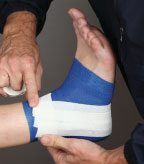My friend Dan Lorenz, MS, PT, ATC/L, CSCS recently summarized two new research articles on ankle taping. Many of us take ankle taping for granted and assume since it is so common that it must be effective. Below is Dan’s summary of the two articles with some of my comments below.
New Research on Ankle Taping

Researchers found that the application of tape actually decreased the ability to detect movements at the ankle. They concluded that the efficacy of taping is unlikely to be explained by an enhanced ability to detect inversion or eversion movements. Two theories exist as to the mechanism of proprioceptive acuity that is believed to improve with the application of tape. One theory is that the close contact between tape and skin increases afferent traffic arising from the cutaneous receptors. The other is that the tape may increase cutaneous input that converges on muscle afferents, thereby increasing excitability of the motorneuron pool.
In another study, Purcell et al examined the differences in ankle range of motion before and after exercise in two tape conditions: traditional cloth tape and self-adherent tape (PowerTape). In both groups, the skin was clean, dry, and unshaven. For the white cloth tape condition, skin was sprayed with tape adherent and prewrap was used. The cloth tape job involved 3 stirrups, two heel locks (one medial and one lateral), and a figure-of-8 strip. In the self adherent group, self-adherent prewrap was applied midcalf to midfoot, incorporating two heel locks. Following this, the wrap was compressed with direct hand pressure.
The self-adherent tape was applied in a similar fashion as the cloth tape, except that heel-lock and figure-of-8 strips were alternated. ROM was measured before, after application of tape, and after 30 minutes of exercise using an electrogoniometer.
Researchers found that white cloth and self-adherent tape both restricted inversion to eversion ROM immediately after application, but with 30 minutes of exercise, only the self-adherent tape maintained the decreased ROM. For plantar and dorsiflexion, both tape groups decreased ROM immediately after application and after 30 minutes of exercise. Researchers concluded that self-adherent tape better restricts frontal plane ankle motion compared to cloth tape, although both do a satisfactory job decreasing sagittal plane motion.
Clinical Implications
It is always good to reflect back on what we do clinically as new research is published. These two articles are interesting and show that ankle taping can be effective in both altering proprioception and limiting ankle range of motion. However, the use of self-adherent tape appears to be more effective than traditional cloth tape.
One of the biggest criticisms of traditional cloth tape was that it loosens over time. It appears that the use of self-adherent tape, such as PowerFlex and PowerTape, are more effective. I have used both and do agree that the self-adherent tape feels great. What do you think?
Here is an example of the self-adherent tape technique:




